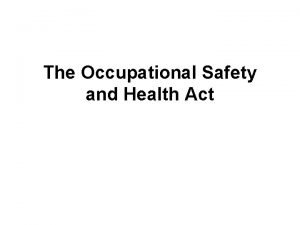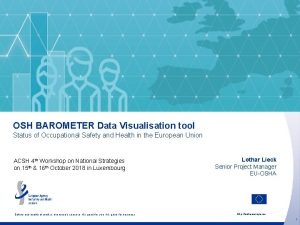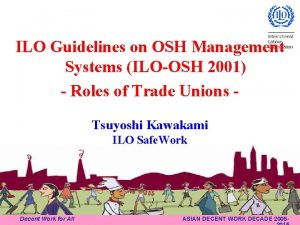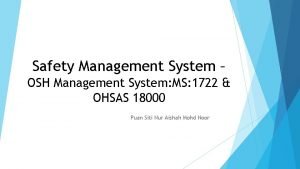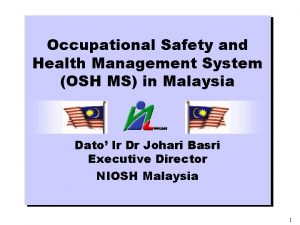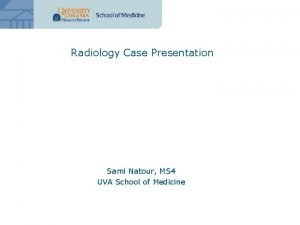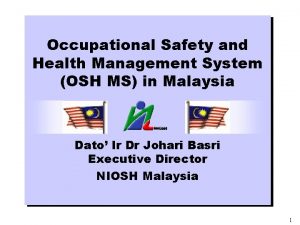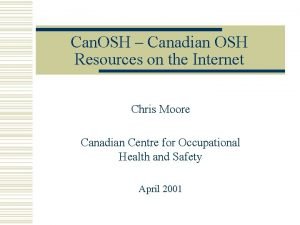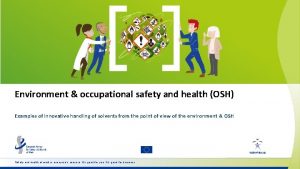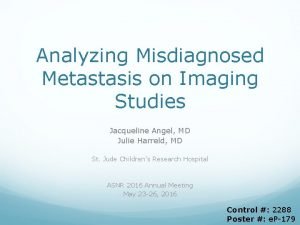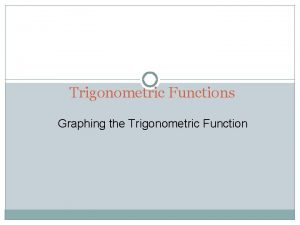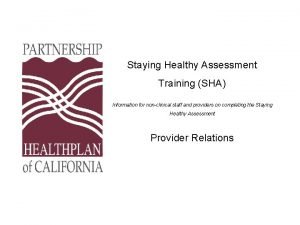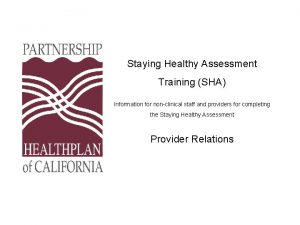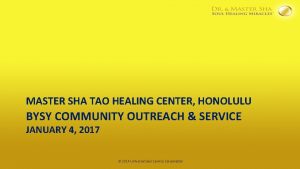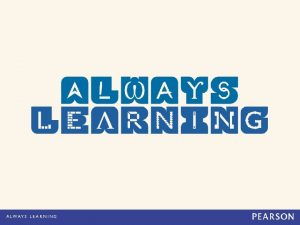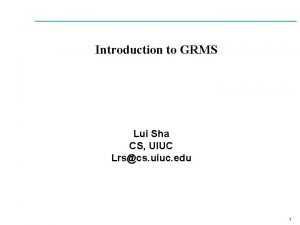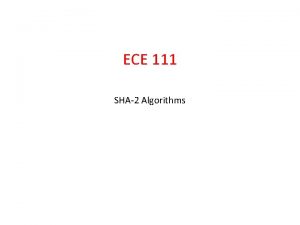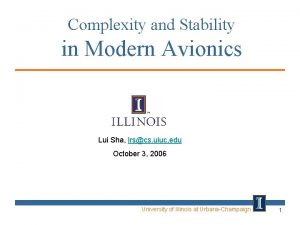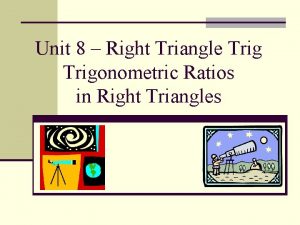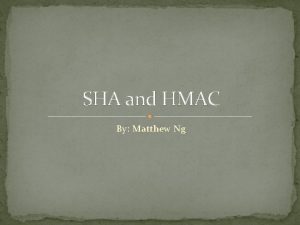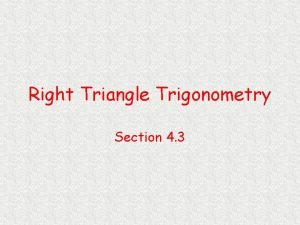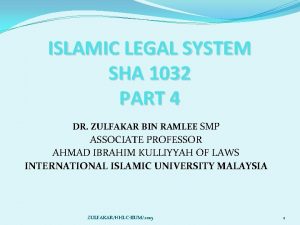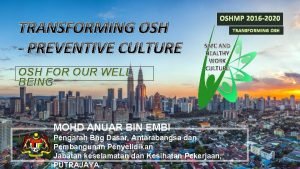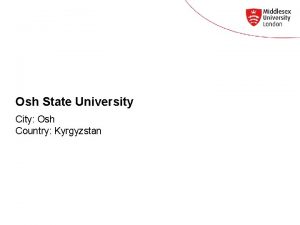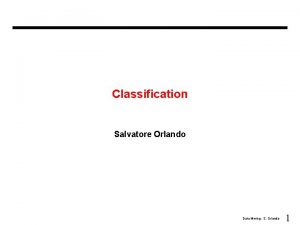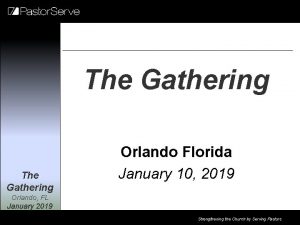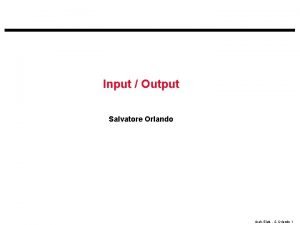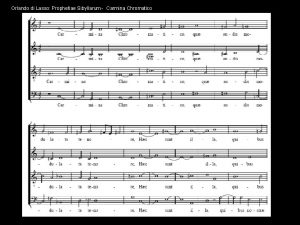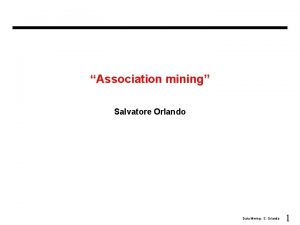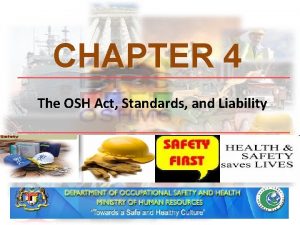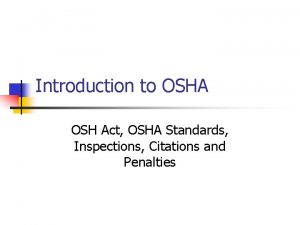OSH and the SHa W Act Orlando Scott


























































- Slides: 58

(OSH and the SHa. W Act) Orlando Scott Senior Assistant General Secretary, BWU, September 3, 2013

Labour’s Role A trade union is a democratic organisation created by workers and run by workers to: l Protect themselves at work; l l Better the Conditions of their lives; and l Improve the Conditions of their Work through Collective Bargaining. l The Procurement of the safety and health of the worker is therefore underscored in that definition

Labour’s Role Labour’s Vision is attaining for workers a Fairer, Better and Healthier Society – to get the best for workers in Housing, Education, Pensions, Human Rights protection & OSH l Labour’s Mission re: OSH is: l (a) to tackle the causes of Accidents & Ill Health at Work; and l (b) to eliminate the causes in both the workplace & the wider society of Poor Health, caused both by Social Inequalities and LIFESTYLE choices, e. g. diet, exercise. l

Labour’s Aims l To build capacity among the workforce through education and training; l Foster partnerships with key partners: l (1) Government – Mo. L, Mo. H, etc l (2) Private Sector, BEC, etc l (3) NGOs Cancer Society, Heart & Stroke Foundation, Diabetes Foundation, (4) International agencies – ILO, etc

Traditional OSH Focus l The traditional (and narrow) approach to: OSH was on Industrial Safety and Health i. e. Workplace Hazards l Physical hazards– noise, extreme temps, vibration l Chemical hazards - mists, dusts, fumes, l Biological – infections, viruses, etc l And most recently Ergonomics

Trend Towards Wellness l l l Labour’s view is that: (1) Barbados is too small, and (2) Human & money resources too scarce for the workplace to focus solely on a single dimension of worker health Man has many dimensions, e. g. , physical, mental, spiritual, etc (3) Barbados has the partnership framework to build synergies and achieve optimum results Hence, the new approach……. .

Changes in Labour’s Role in OSH l l l Labour’s new approach to OSH is holistic & transcends traditional OSH pursuits to include: Public Health issues: Infectious diseases, e. g. HIV and AIDS, Violence, Substance abuse NCDs – cardiovascular disease, cancer, diabetes, chronic respiratory diseases; Mental Health issues stress, burnout, anxiety & depression; psychological violence - bullying Women’s and men’s issues – e. g. The menopause, Pregnant worker – hence wellness

Why The Wellness Approach? Wellness is an active process of becoming aware of, and making choices toward, a healthy and fulfilling life l “a state of complete physical, mental and social well-being, and not merely the absence of disease or infirmity/ill health. l The interrelated dimensions of wellness include – physical, emotional, intellectual, spiritual, social, environmental and occupational. l For us, each dimension is equally vital in the pursuit of optimum health l

Basis for Change in OSH Focus l l l NCDs - leading causes of illness & death in B’dos with CVDs, cancer & diabetes in the lead; Up to 1/4 th of all Bajans have an NCD 6 out of every 10 deaths result from complications NCDs 5% of GDP of Barbados spent on NCDs responsible for 63 % of all deaths worldwide with 80% of those deaths coming from low-income countries ½ of those who die worldwide are in the prime of their lives

Employee illness affects a Co’s profitability directly l Economic costs Studies show that each day of absence due to illness is equivalent to almost 6 times loss of worker productivity per year; l Workers who are unable to concentrate at work due to illness or family illness – ”presenteeism” translates to 8 times of reduced worker productivity; and l Productivity losses from “presenteeism” exceed the costs of absenteeism and medical disability combined. l

HIV and AIDs continue to be a major workplace health and developmental issue in Barbados l Since 1984 when the first death was formally recorded, 1, 436 persons in Barbados have died from complications resulting from the condition l 1, 049 men and 387 women have died l 156 new cases reported in 2008 – 93 (male) and 63 (female) l l

HIV and Aids Ages of new HIV cases ranged from 17 years to 81 years l 70. 5% of all new cases were adults between the ages of 20 to 49 years l The age group with the greatest proportion of new HIV cases is 30 to 39 years l The median age of someone being diagnosed with HIV in Barbados was 36. 5 years – males being diagnosed with HIV at age 40. 9 years and females 30. 7 l

Occupational Safety and Health (OSH) l In 1963, a joint committee of the ILO/WHO defined OSH as the promotion & maintenance of the highest degree of the l Physical, l Mental; and l Social well-being of workers in all occupations;

OSH definition, cont’d (a) Placing and the (b) maintenance of the worker in an occupational environment adapted to his or her l The (a) physical; and l (b) mental needs. l

Occupational Safety and Health (OSH) l OSH is a discipline with a broad scope involving many specialised fields, e. g. l Engineering l Medicine l Environmental science l Ergonomics l Industrial Hygiene; and l Statistics

The new trend in OSH is the increase: l In musculoskeletal problems l Stress and mental health problems Asthmatic and allergic reactions; and l Problems caused by hazardous material, including cancer-causing agents l Violence ranging from homicidal & physical attack, to bullying, harassment and sexual or racial attacks l

Concerns re: stress are surfacing because of: l l l The global recession Pressure of globalisation and increased worldwide competition, new technologies, deskilling, downsizing, job losses, job insecurity and poorer conditions of work Violence at work is another worrying development

Insidious hazards fall into the following categories: l Chemical hazards – arising from liquids, solids, dust, vapours, gases; l Physical hazards – noise , vibration, unguarded machinery, lighting, radiation, extreme temperatures; l Biological hazards – infestations, bacteria, viruses, infectious wastes; and l Psychological – stress, burnout, anxiety, depression

Insidious Hazards, cont’d Non-application of Ergonomic principles, e. g. badly designed machinery and tools l Ergonomics – is the study of how a workplace and the equipment used there can best be designed for (a) comfort, (b) efficiency, © safety and (d) productivity l Ergonomics is about factors in a workplace or design of equipment, used by people at work that contribute to comfort, efficiency, safety and ease of use l

Why the SHa. W Act l Appropriate Legislation & Regulations, together with adequate means of Enforcement are essential for the protection of workers’ Safety & Health l Legislation is the very foundation of social order l Without legislation or its enforcement, the door is wide open to all forms of workplace ABUSE

Legislation The Factories Act 1982 was narrow in scope and out of date l Enacted when the economy had already achieved diversification l Sugar’s influence had declined – fewer factories l Tourism & Services were key money earners l

SHAW ACT 2005 -12 l SHa. W Act applies to all workplaces – exception being l (a) The Military, l (b) Domestic service in private households; and l © Some aspects of work done aboard ships

Key features of Act

Definitions. for the purpose of the Act l WORKPLACE means any place where persons work or are employed, including a factory, but does not include a private household where persons work or are employed only in domestic service

Definitions l Employee means any person who has entered into works under a contract of service or apprenticeship with an employer to do any skilled, unskilled, manual, clerical, or other work for hire or reward, whether the contract is expressed or implied, oral or in writing or partly oral and partly in writing, and includes a public officer.

Definitions l An employer means a person who employs persons for the purposes of carrying out any trade , business, profession, vocation or apprenticeship. l Occupier means the person who has control over a workplace and the work that is done there

Key features of the Act l Part 11 – General Duties l A wide range of persons have been brought under the Act: l Employers l Designers l Importers; and l Manufacturers

COMMON HAZARDS - SCHOOLS l School environment is part of the community (a) intruders, (b) acts of violence, © narcotics, (d) grass fires and chemical wind drift, (e) rodent infestation l Public health issues associated with school life (a) sanitation of food services, (b) HIV and AIDs + other infectious diseases – training for staff re: universal precautions

Common school hazards Teachers all things to all students – banker, care-giver, counselor, father, mother, etc l Teaching is a profession characterised by a high degree of stress and burn-out l Some stress caused by Organisational factors such as (a) curriculum concerns, (b) career advancement, © student motivation, (d) class size, (e) role conflict, (f) students/parents misbehaviour l

Common school hazards l Teachers who specialise in technical fields may be exposed to specific occupational hazards: l Arts and craft – chemicals, e. g. organic solvents, pigments and dyes, metals and metal compounds, wood dust l Chemistry and biology teachers biohazards

Teachers face the hazards found in indoor and office environments: l Indoor air pollution l Poor lighting l Heat, l Overcrowded class rooms, overloaded schedules l Inadequate facilities l Ergonomic problems from poorly designed furniture

Some Key Issues in SHAW Act Employers required to conduct RISK ASSESSMENTS prior to introducing any new material, article, equipment or process l The assessment shall be reviewed where there has been material change in the work or the circumstances under which the work is carried out l Duty of persons who erect or install articles that there are no risks to HEALTH once the article is properly used*

A Risk Assessment is the process where you: l (1) Identify hazards, l (2) Analyse or Evaluate the risk associated with hazards; and l (3) Determine the appropriate ways to eliminate or control the hazards. l Risk assessment is a thorough look at the workplace to identify things, situations, and processes that may cause harm.

Risk Assessment l After identification is made of the Hazard, you will then EVALUATE how LIKELY and SEVERE the risk is, and then decide what measures should be implemented to effectively l (1) Eliminate l (2) Prevent; or l (3) Control the harm from happening.

Risk Assessments in Offices l White collar workers are more exposed to health risks than physical risks l - stress l - Sick building syndrome l - musculoskeletal disorders l There are no regulations to deal with such as issues as l Mental health and drug use

Material Safety Data Sheets Under the new provisions (S. 86 (1) (b) (i), it shall be the duty of the Occupier to have adequate material safety data sheets available (MSDS) which contain adequate information about any material, tool, article/thing, or substance intended to be used in the workplace as well as any applicable precautions to be observed l All workers likely to be affected by such use, shall have access to that information. l

Approach to management of OSH l The principle of the Joint Responsibility System is promoted and found in ILO Convention 155 on OSH, Article 20, ILO Recommendation 164, Article 12, which reads: “the measures taken to facilitate the cooperation between management and workers and or their representatives should include, where appropriate and necessary, the appointment, in accordance with national practice, of workers’ safety delegates, , of workers’ S&H committees, and or joint S&H committees.

Joint OSH Committees l Committees, comprising Employers and Workers, are key to the maintenance of safety and health at the workplace l Through meetings, formal inspections, a walk-through, working with Department of Labour, etc l Education of workforce

Safety organisation is a key OSH issue. SHa. W Act states (Section 103 (1) l l l Joint OSH committees mandatory where there are 25 or > employees Committees have access to information re: articles & substances used at work Recommendations recommended when once they are practicable Committees comprise equal numbers of employers and employees reprs. Employees’ reps appointed through their unions

Joint OSH Committees l l l l Under the SHa. W Act, no employee can be dismissed for requesting an inspection of his workplace Benefits derived from the committees: - workers can contribute to prevention by (a) spotting; and (b) warning about potential hazards © educate and motivate workers to cooperate in promotion of OSH (d) workers are involved re: decisions that affect their life, health & well-being

Agenda l l l The agenda should permit the committee to the following: The PLAN, WHO, HOW, and WHEN, and when functions are performed Hear reports from the whose on how it went Monitor and control these functions Assess how well functions are carried out and consider recommendations

Preparing Minutes l l l Minutes record the following information: - when/where the meeting took place - who were present; their role at the meeting - agenda items discussed - key information re: each agenda item that’s considered; Decisions and action necessary and who is responsible

Key issues in SHAW Act Right to Refuse l Section 104 – where, during his employment there is sufficient evidence to indicate that an employee’s health and safety are in imminent danger that employee may refuse to carry out the tasks assigned to him, pending consultation with safety committee, trade union, staff association or the CLO. l

Approach to Management of OSH l The SHa. W Act also clearly defines the roles of: l Government; l Employers; and l Workers

General Duties of Employers l Part 11 Section 6 outlines the General Duties of an Employer…. l “it shall be the duty of every occupier, so far as is reasonably practicable, to ensure the health, safety and welfare at work of all his employees (Section 6 (5).

Every Occupier shall: Section 7 Keep his workplace so that the safety and health of employees is not endangered; l Take such precautions to ensure safety of every person in the workplace; and l Ensure a all employees with special needs shall be given any directions, information or training that are required to be give, , by any method of communication that readily permits the employees to receive it. l

It is the General Duty of every Occupier to: Conduct his undertakings in such a way as to ensure, so far as is reasonably practicable, that persons NOT IN HIS EMPLOYMENT who may be affected thereby are not exposed to risks to their health and safety l Prepare a General Policy on OSH and Welfare l Where > persons are employed the policy shall be in writing l

General Duties of Employees S. 9 l (1) Secure the safety and health of self and others l Cooperate with the Employer to ensure compliance in respect of the law l Report to the employer infractions of the legislation l Use PPE correctly; and not misuse anything provided in accordance with legislation

Key Issues Employers of NEW and EXPECTANT mothers MUST conduct RISK ASSESSMENTS once the worker notifies the employer in writing of her condition. l Depending on the outcome of the risk assessment, it may be necessary for the NEW or EXPECTANT mother to be given suitable alternative work during the pregnancy and for 6 months after the birth of the child. l The rationale is to protect the health of mother and child. l

Key issues: who is responsible for OSH? l Part 1 l Section 5 (2) l Where an owner or occupier enters into a contract with sub contractors to undertake civil works of engineering construction on his behalf, the OWNER SHALL be RESPONSIBLE for maintaining Safety in the Workplace.

Key issues l The SHa. W Act also provides for employers to cater to employees with SPECIAL NEEDS – persons with disabilities l - provision of communication that is effective to allow for the worker to receive the information and warning in case of emergency l Fire alarms need to be visible and audible.

Other key issues Persons who desire to take into use preowned or used machinery shall give a month’s notice to the CLO containing, among other matters: l Name of the business & name of occupier of the business l Name & address of the owner of the premises; postal address of workplace, including its exact location; and l Details of the machinery to be used l

No person shall be employed at a machine unless he: (a) Has been fully instructed re: l (1) Working of the machine (2) dangers arising in connection with the machine; and (3) the precautions to be observed while working in connection with the operation of the machine; and l (b) he has received sufficient training in the working of the machine or is adequately supervised during the course of his work in connection therewith. l

Other Key Issues in SHa. W Act Part 1 V – HEALTH l Cleanliness – every workplace shall be kept in a clean state and free from effluvia arising any drain, sanitary convenience … l Temperature – effective provision shall be made for securing & maintaining a reasonable temperature in each workroom l Overcrowding – a workplace shall not be so overcrowded as to cause risk of injury to the health of the persons employed there l

Other key HEALTH issues l Lighting – effective provision shall be made for securing and maintaining, in every part of a workplace where persons are working or passing, sufficient and suitable lighting, natural or artificial l Noise and Vibration – every owner, occupier or employer shall take adequate steps to prevent hearing impairment caused by noise, and disease caused by vibration from occurring to persons in, or in the vicinity of his workplace and shall comply with directives.

WELFARE, Part V Provisions made for (57. (1) supply of drinking water; washing facilities 58 (1) l Lunchrooms 59 (1) where 10 or more persons are at any one time employed in a workplace there shall be provided and maintained in such a workplace for the use of all persons employed therein a suitable and adequate room furnished with an adequate number of tables and seats for the taking of meals l

Welfare – Part V Provision also made for (1) Changing facilities, (2) accommodation for clothing, (3) Sitting facilities, and (4) Rest rooms, l First aid – there shall be provided and maintained so as to be readily accessible, a First Aid Box or First Aid Cupboard of a standard approved by the CLO, in consultation with the CMO and where more than 150 persons are employed, there shall be an additional box or cupboard for each additional 150 persons l

Shaw Act l Have a good one!
 William steiger act
William steiger act Osh barometer
Osh barometer Iloosh
Iloosh Osh-ms 1722 component
Osh-ms 1722 component Popea osh
Popea osh Uva radiology tutorial
Uva radiology tutorial Osh ms
Osh ms Canosh
Canosh Osh state medical university logo
Osh state medical university logo Osh examples
Osh examples Osh mri
Osh mri Macbeth summary
Macbeth summary Domain of trig functions
Domain of trig functions Domain of tangent function
Domain of tangent function Sha questionnaire
Sha questionnaire Staying healthy assessment
Staying healthy assessment Hash value check
Hash value check Master sha
Master sha Ntu
Ntu Sha questionnaire
Sha questionnaire O&sha
O&sha Sha 3
Sha 3 Astd inf meta
Astd inf meta Lui sha uiuc
Lui sha uiuc Sha in network security
Sha in network security Rei ticker symbol
Rei ticker symbol Sha base valenti
Sha base valenti Functie hash
Functie hash Sha-0
Sha-0 Lui sha uiuc
Lui sha uiuc Sha 2
Sha 2 Cho sha cao
Cho sha cao Sha
Sha Trig functions for non right triangles
Trig functions for non right triangles Sha
Sha Sha 256
Sha 256 Generate sha-1 android studio
Generate sha-1 android studio Sha condivise
Sha condivise Hát kết hợp bộ gõ cơ thể
Hát kết hợp bộ gõ cơ thể Ng-html
Ng-html Bổ thể
Bổ thể Tỉ lệ cơ thể trẻ em
Tỉ lệ cơ thể trẻ em Chó sói
Chó sói Chụp tư thế worms-breton
Chụp tư thế worms-breton Chúa yêu trần thế
Chúa yêu trần thế Môn thể thao bắt đầu bằng từ chạy
Môn thể thao bắt đầu bằng từ chạy Thế nào là hệ số cao nhất
Thế nào là hệ số cao nhất Các châu lục và đại dương trên thế giới
Các châu lục và đại dương trên thế giới Cong thức tính động năng
Cong thức tính động năng Trời xanh đây là của chúng ta thể thơ
Trời xanh đây là của chúng ta thể thơ Mật thư tọa độ 5x5
Mật thư tọa độ 5x5 Làm thế nào để 102-1=99
Làm thế nào để 102-1=99 độ dài liên kết
độ dài liên kết Các châu lục và đại dương trên thế giới
Các châu lục và đại dương trên thế giới Thơ thất ngôn tứ tuyệt đường luật
Thơ thất ngôn tứ tuyệt đường luật Quá trình desamine hóa có thể tạo ra
Quá trình desamine hóa có thể tạo ra Một số thể thơ truyền thống
Một số thể thơ truyền thống Cái miệng xinh xinh thế chỉ nói điều hay thôi
Cái miệng xinh xinh thế chỉ nói điều hay thôi Vẽ hình chiếu vuông góc của vật thể sau
Vẽ hình chiếu vuông góc của vật thể sau
